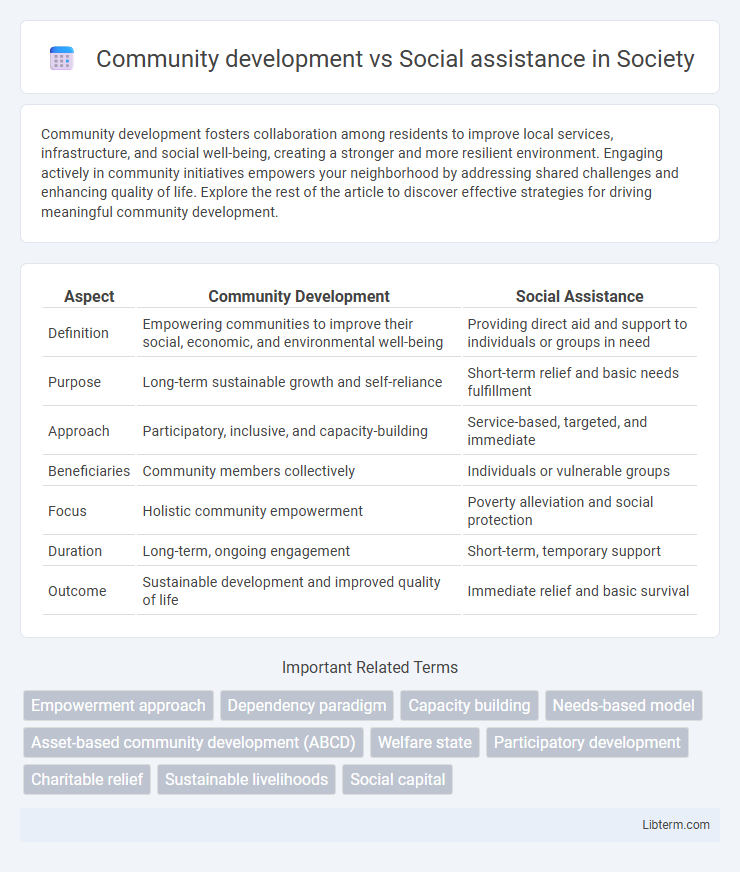Community development fosters collaboration among residents to improve local services, infrastructure, and social well-being, creating a stronger and more resilient environment. Engaging actively in community initiatives empowers your neighborhood by addressing shared challenges and enhancing quality of life. Explore the rest of the article to discover effective strategies for driving meaningful community development.
Table of Comparison
| Aspect | Community Development | Social Assistance |
|---|---|---|
| Definition | Empowering communities to improve their social, economic, and environmental well-being | Providing direct aid and support to individuals or groups in need |
| Purpose | Long-term sustainable growth and self-reliance | Short-term relief and basic needs fulfillment |
| Approach | Participatory, inclusive, and capacity-building | Service-based, targeted, and immediate |
| Beneficiaries | Community members collectively | Individuals or vulnerable groups |
| Focus | Holistic community empowerment | Poverty alleviation and social protection |
| Duration | Long-term, ongoing engagement | Short-term, temporary support |
| Outcome | Sustainable development and improved quality of life | Immediate relief and basic survival |
Defining Community Development
Community development is a participatory process aimed at empowering local populations to initiate and sustain improvements in their social, economic, and environmental conditions. This approach emphasizes capacity building, collective decision-making, and long-term transformation rather than temporary relief or aid. Unlike social assistance, which provides immediate support to individuals in need, community development fosters self-reliance and systemic change by mobilizing community resources and fostering networks.
Understanding Social Assistance
Social assistance refers to government or organizational programs designed to provide financial support and essential services directly to individuals and families in need, aiming to alleviate immediate hardship and improve quality of life. It includes welfare benefits, food stamps, housing subsidies, and healthcare aid targeted at vulnerable populations to ensure basic living standards. Understanding social assistance involves recognizing its role as a short-term safety net rather than a long-term solution for systemic poverty or community empowerment.
Goals and Objectives: Community Development vs Social Assistance
Community development aims to empower individuals and groups by fostering sustainable growth, enhancing local capacities, and promoting social cohesion through collaborative efforts. Social assistance focuses on providing immediate relief and support to vulnerable populations, addressing basic needs such as food, shelter, and healthcare to alleviate poverty and hardship. The goal of community development is long-term systemic change, while social assistance targets short-term crisis intervention.
Approaches and Methodologies Compared
Community development emphasizes participatory approaches that empower local stakeholders through capacity building, collective decision-making, and sustainable resource management. Social assistance typically employs targeted methodologies, such as direct aid, welfare programs, and short-term interventions, aimed at alleviating immediate needs of vulnerable populations. While community development fosters long-term socio-economic transformation by engaging the entire community, social assistance focuses on immediate relief and support through structured service delivery systems.
Impact on Local Communities
Community development fosters long-term empowerment by enabling local residents to actively participate in decision-making and resource management, leading to sustainable economic growth and improved social cohesion. Social assistance provides immediate relief to vulnerable populations through welfare programs and financial aid, reducing poverty and addressing urgent needs but often with limited lasting impact. Both approaches influence local communities differently, with community development emphasizing systemic change and social assistance prioritizing short-term support.
Sustainability and Long-term Effects
Community development fosters sustainability by empowering local populations through capacity-building and resource management, leading to self-reliant communities with lasting economic and social benefits. Social assistance provides immediate relief to vulnerable groups but often lacks mechanisms for long-term impact and may create dependency without addressing systemic issues. Emphasizing community development enhances resilience and promotes enduring social change, whereas social assistance primarily addresses urgent needs without ensuring continued progress.
Empowerment vs Dependency
Community development fosters empowerment by enabling individuals to actively participate in decision-making processes, build skills, and create sustainable solutions tailored to local needs. Social assistance often addresses immediate needs through resource distribution, which can inadvertently create dependency by reducing incentives for self-reliance and long-term growth. Emphasizing empowerment in community development reduces dependency and promotes resilience, leading to lasting social and economic improvements.
Stakeholder Involvement and Participation
Community development emphasizes active stakeholder involvement by engaging local residents, organizations, and businesses in decision-making processes to foster collective ownership and sustainable progress. Social assistance typically involves targeted aid delivered by government agencies or non-profits, with limited direct participation from beneficiaries, focusing more on providing immediate support than collaborative empowerment. Effective community development relies on inclusive participation to identify needs and implement solutions, whereas social assistance primarily addresses individual or household needs through predefined programs.
Funding and Resource Allocation
Community development emphasizes long-term funding strategies that promote sustainable growth through collaborative resource allocation, enabling communities to build capacity and resilience. Social assistance prioritizes immediate funding for essential services and direct aid, focusing on short-term relief to vulnerable populations. Resource allocation in community development is typically decentralized and participatory, whereas social assistance relies on centralized, government-driven budgets aimed at basic needs fulfillment.
Integrating Community Development with Social Assistance
Integrating community development with social assistance enhances sustainable impact by addressing both immediate needs and long-term empowerment. Community development fosters local capacity-building, while social assistance provides crucial safety nets for vulnerable populations. Combining these approaches promotes holistic well-being, resilience, and equitable growth within communities.
Community development Infographic

 libterm.com
libterm.com